Okay, der Fairness halber will ich in diesem Beitrag mit allzu harscher Kritik vorsichtig sein, da ich mich selbst seit gut und gerne vier Jahren mit dem so genannten Bürgerjournalismus, Social Media und den (Online-)Strategien von Printmedien auseinandersetze.
Dennoch sei folgender Hinweis gestattet – und er gibt glaube ich den Eindruck im Publikum wieder: Die Moderatorenposition der Diskussion „Der Bürger als Journalist: Geliebt oder geduldet?“ war nicht gerade ideal besetzt, aufgrund nicht weit genug reichender Themenkenntnis. Da waren doch ein paar sehr krude Behauptungen und Fragen dabei, die es unter anderem erschwerten, dass man bei der Debatte zum Thema tatsächlich mal weiterzukommen, als bei den ungezählten Diskussionen zur gleichen Thematik aus den vergangenen Jahren.
Glücklicherweise haben die beiden eigentlichen Protagonisten auf dem Panel, Katharina Borchert, Online-Chefin von DerWesten, dem Onlineportal der WAZ, und Jochen Wegner, Chefredakteur von Focus-Online weitestgehend dagegen halten können und von ihren aktuellen Erfahrungen in ihren jeweiligen Online-Communities berichtet. Deutlich wurde dabei, wie wichtig das Community-Management an beiden Standorten im täglichen redaktionellen Flow inzwischen ist, Man ist im Dialog mit der Zielgruppe – und das quasi in Realtime!
Sowohl Borchert als auch Wegner gaben sich begeistert von ihrer Community, wenngleich sie nicht leugnen, dass es auch die notorischen Dauernörgler und Trolls gibt sowie weitere Umstellungen in den redaktionallen Abläufen (Online First, Newsdesk etc.), die die Macher der Onlineangebote herausfordern. Für Jochen Wegner gehört der Input von Seiten der User inzwischen zum Real-Estate eines modernen journalistischen Internetangebots. Katharina Borchert kann das nur bestätigen. Ihre Erwartungen ob, wie und in welchem Umfang die Leser von DerWesten sich aktiv auf der Website einbringen wurden übertroffen.
In die Begeisterung mischt sich aber auch immer wieder Minifrust, eben weil bei bestimmten Themen die Diskussionen aus dem Ruder laufen. Dennoch: Zuhören was die User sagen, ernst nehmen was die Community bewegt, Moderator und Streitschlichter sein, all das gehört inzwischen zu den Aufgaben der Communitymanager in den Verlagen und das nicht 9 to 5, sondern 24/7, in realtime.
Was das für die Zukunft der Ausbildung bedeutet, wurde im Panel leider nicht behandelt, aber eines ist klar: Es geht nicht darum den „Amateur“, den User, den Leser zum „(Bürger)Journalisten“ zu „erziehen“, sondern zusammen mit den neuen Medienprosumern zu lernen, wie man gemeinsam die Zukunft der Webangebote von Medienhäusern gestaltet.
Mai 2008
Warm welcome & cold drinks
Props to the organizers: Except for the wireless that keeps cutting out – and let’s face it: At which conference doesn’t it? – everything works just fine.

Not only is there enough juice for my laptop, but also for me. (Hint: Power outlets at all the columns!) Even standing here behind Conference Room 1, out in the shade by the lonely LAN cable that allows me to post this, a friendly soul of the catering service brings me an ice-cold drink.
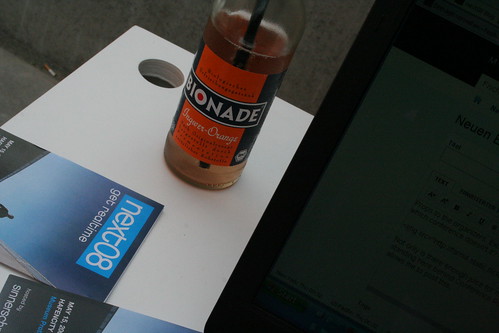
Neat. Thanks to the great service staff!
Just sayin‘.
Jeremy Ruston, British Telecom meets Luis Suarez Rodriguez, IBM: Decaffeinating Tea
First up: Jeremy Ruston of British Telecom.
„Decaffeinating Tea, what’s that supposed to mean?“, you might be asking yourself. (I sure did.) What’s hiding behind the slightly odd title is the question of how individuals are treated, and how they function, in large corporations. Most importantly, what has changed for employees as a person and for the enterprise in what today we call Enterprise 2.0?
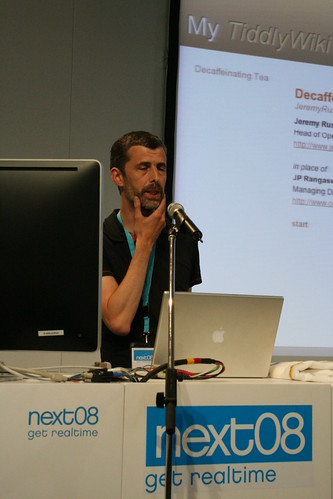
Trust in enterprises has always been a problem: As a cog in the machine, the employee has never been faced with too much trust by their enterprises. In the digital age, things got even worse, just think of the stories you’ve heard about emails where colleagues have cc’d (or even bcc’d) the boss for strategic reasons, i.e. because they didn’t trust their colleagues.
Time, and how people spend it in their jobs, is another issue. Good question raised by Jeremy: If Google’s (or any other company’s for that matter) employees spend 20% of their time researching on stuff they’re personally interested in, what do they work on the other 80% of their working time on?
Teenagers today grow up with an incredibly high media and technology awareness and the relevant skills. Those Digital Natives really know their tech, and their web 2.0 tools. How can enterprises exploit this, or at least not scare those future employees away? After all, if a digital native isn’t able to apply his skills and knowledge in his workplace because corporate policies and infrastructure won’t allow the tools and practices, it’s a lose-lose situation: The employee will be frustrated, the employer can’t get the maximum value for their money.
So how does British Telecom harness the Web 2.0 generation? According to Jeremy Ruston, BT has been pretty early on in the adoption curve. Just to give an example: Use of Facebook was encouraged early on.
Next up: Luis Suarez Rodriguez of IBM.
IBM, if Luis Suarez is indication, is pretty far ahead on the adoption curve. „Collaboration allows us to tap into the power of people“ says one slide which analyzes how we ask out peers and friends for advice in one-on-one situations. How to harness this very mechanism and make it scale to larger groups is one of the big challenges being tackled in our days.
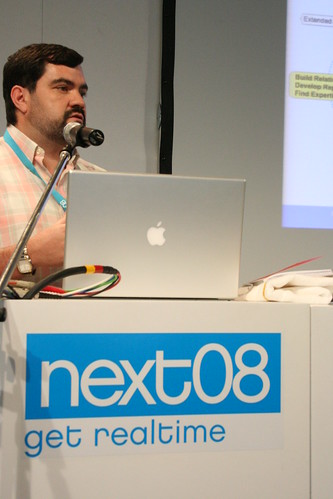
Now it would be great to not only explicitly ask for advice, but to also collaborate more implicitly. Do I really have to write an email to find out which music album to buy as a birthday gift? Probable not – if you manage to tap into smart communities. Technology can enable and foster this kind of exchange, it can help foster relationships between individuals, thus creating a community. It’s people, not data. That’s the very core of online collaboration.
Email is obviously not the way to go. (Challenge: Ask Stowe Boyd about email!) So how can we harness the power of communities? Trust is a key issue: Without trust you cannot anything done. The main challenge, though, is to shift from a controlled, regulated environment to a dynamic environment that fosters spontaneous collaboration – forget org trees! Rodriguez’s message is clear: Email is too inflexible, go for Wiki-style collaboration. (With this presentation, he could’ve easily passed at a Barcamp, too – they’d have loved him.)
Jimmy Maymann, GoViral: Branded activities and social media in the age of Youcracy
The key message in this panel is clear: The age of traditional branding is over. As our connectedness and social life online evolve, branding too becomes more social: Brands increasingly have to rely on their customers‘, friends‘ and social networks‘ recommendations – which is also the core of viral marketing. It it’s not funny, inspiring or otherwise compelling (Maymann calls it emotional, you wouldn’t pass that YouTube video on to your friends, right? But if you do, your friends might watch it just because it was you who sent it. You basically vouch for the content you pass along.
Of course this puts campaigners and communications agencies into a tricky situation: On the one hand, they want to push their clients‘ messages out there; on the other hand, they need the help of those very customers they’re trying to target. Go wrong, and your customers will hold it against you. Social media need a very different approach than traditional media if you want to succeed.
One lessen I learned today? Obviously, if you plan on going viral, funny videos are still the way to go.
Great question from the audience: Social media seem to aim primarily at younger target groups, 40 to 50 years at max. With the massive demographic shift, how can companies reach out to older audiences and engage with them? Maymann doesn’t have the answer. Let’s not hold it against him just yet: The whole field of social media is so young that it’ll need a few years to mature along with those not-so-young folks out there.
Werner Vogels of Amazon: Compete on ideas not resources
„Shut up!“ Werner Vogels of Amazon makes it very clear that all the chatting isn’t really appreciated. The new-found silence is greeted by the audience with applause. Now we can start. Animoto serves as an example to demonstrate Amazon’s Webservices. Animoto, which is basically a slideshow creator on speed (that combines images and sounds to create compelling videos) lives completely in the cloud. Practically all info is pulled in from external services (Flickr etc.) and processed on flexible Amazon server cycles, where the videos are rendered.
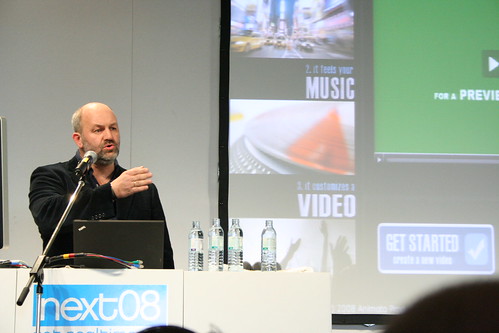
This may not sound too special, but it really is, if you think about it: There’s basically no hardware in the whole company, no server infrastructure to be maintained. Everything you need you can rent on the web as you grow: Animoto wa slowly growing until they launched a Facebook app – and went completely viral. Just a few years back, this would have lead to insurmountable scalability issues, these days you can think about scaling when you actually need it. So here we pretty much have a radically different situation for entrepreneurs. (According to the presentation, web companies used to spend 70% of their time on infrastructure work and only 30% on innovation. Amazon claims this has changed. A lot.)
Another issue with regular, central server centers: You might remember the major outage of a big San Francisco-based service provider a few months back. Despite their eight diesel power generators, during a power outage they couldn’t keep up their servers – six of the backup generators failed, according to this speech. A good chunk of the web services based in the Bay Area died that day. This might actually really be a good reason for decentralized hosting.
So far, this speech has been more convincing than some of the presentations in the Elevator Pitch Panel, so it should be interesting to see what the more technologically inclined members in the audience will be asking. Server admins, step forward!
Question from the audience: What about Security? Of course, that’s one of the key aspects for practically any serious startup. Legal jurisdictions are a challenge here – depending on where your data is stored, different laws and regulations apply, different governmental and non-governmental players could get access to your (and your users‘) data.
I’d be curious: Who has experience with Amazon webservices or their Automatic Backup USB Stick? If you do, please share in the comments.
Free! Wie wir morgen Musik kaufen.
Sie erinnern sich? Das mittlerweile fast in die Pupertät gekommene Kind, das irgendwann um das Millenium herum in Brunnen gefallen war: Klar, die Musikindustrie. Man kann nicht aufhören sich damit zu beschäftigen und sich aufzuregen aber man muss zugestehen, dass es mittlerweile einige interessante und wegweisende Entwicklungen gab. Zeit also zwei Beteiligte zu befragen, die diese Änderungen weit vorne begleiten. Stefan Glänzer von LastFM und Ingo Vandre von SPV.
Gleich zum Einstieg erwähnt Stefan Glänzer die 35% Marktanteil, die in die Musikindustrie mittlerweile im digitalen Bereich umsetzt und die immer noch enorm steigen.
Vandre weist seinerseits auf die gestiegene Komplexität der Musikveröffentlichung hin: Früher gab es 10 verschiedene Konfigurationen (Single, Maxi, Vinyl etc.), heute sind es mit all den Klingeltonvarianten, Wallpaper und anderen digitalen Fan-Gimmicks bis zu 100. – Die Musik selber, so seine These, wird in Zukunft frei verfügbar sein.
Auch Glänzer meint, man müsse andere Wege der Vermarktung finden und behauptet, dass Künstler vor allem gehört werden wollen und dass ihnen das Geld verdienen zumindest sekundär sei. Die alte These, des leeren und deswegen kreativen Magens?
Die zunehmende Segmentierung des Medienkonsums, (ein Phänomen, das auch als der „Long Tail“ bekannt ist), bekommt noch ein schönes und treffendes Zitat:
„Was ist Qualität? Qualität ist das, was ich mag. Jede Band auf der Welt hat mindestens 50 Fans verdient.“
Interessant war die Aufteilung der Margen bei LastFM. Je nach Nutzungsart (Radiostream, Direktauswahl, Abonement, Affiliatelink-Klick) werden die Einahmen nach verschiedenen Schlüsseln an die Künstler ausgeschüttet.
Ob sich das rechnet, fragt der Moderator. Die langgezogene Pause, die dann folgte, provoziert nicht wenige Lacher.
Der Werbeblogger (der eine, nicht der andere) fragte dann noch die Frage, die sich jeder Musikkonsument wohl schon mindestens einmal gefragt hat: „Ärgert sich die Musikindustrie nicht schwarz, dass sie den Zug derart verpassen konnte?“
Natürlich sei das nicht einfach, wenn einer umsatzstarken Branche plötzlich das Geschäftsmodell wegbricht, antwortet Vandre, „da kann man ja auch nicht einfach sagen: hier, nehmt alles umsonst.“
„Aber natürlich„, räumt er ein, „seien viele Fehler gemacht worden. Da hätte manches intelligenter laufen können.“ Was er aber nicht verstehe, ist warum die Filmindustrie heute die selben Fehler macht, wie die Muskindustrie, obwohl das ganze Dilemma doch schon exerziert wurde. Da kann ich mich nur anschließen.
Startuprunde 1 mit u.a. 1000Mikes, Juicywalls and Soundcloud
Diese Konferenz ist dicht und warm und man ist immer in Eile und kommt meistens zu spät. Also auch zu spät um noch die Vorstellungen von Wooby, das schick aussieht und sich mit Bewertungen und Listen beschäftigt und Viif leider verpasst. Viif nutzt den vergessenen UMTS Videokanal um Live-Video ins Netz zu streamen.
1000Mikes – Talk Radio 2.0
1000 Mikes heißt Live Audio ins Netz – jeder kann einen eigenen Kanal einrichten und dann eine Hamburger Nummer anrufen. Zack, dann streamt man live ins Netz.
Der gebührend aufgeregte Gründer Frank Felix Debatin rechtfertigt sich, dass er Audio macht und nicht Video. Das ist eigentlich ganz unnötig, denn die Idee ist kompakt und klein und lässt viel Fantasie für mögliche Anwendungen. St Pauli Spiele live z.B. – Tatsache, das gab es ja sogar. Der DFB ist informiert, hat sich aber noch nicht beschwert. Na also, mit Video wär das nicht gegangen. Achja, das Geschäftsmodell: Werbung. Der Moderator drückt eine Taste und dann kommt ein Spot, an dem der Sendende mitverdienen soll. Auch das ist schön einfach. Man kann sein Radio embedden oder die Stream-URL im Blog, Twitter oder was immer Social Dings angeben.
Juicy Walls
Juicy Walls kommt von Atmos4, einer aus dem Grafitti kommende Plakat und Designagentur, die Außenfassaden, für Werbekunden gestaltet. Aus den häufigen Anfragen von Freunden, ob man nicht mal die eigene Wohnung designen wollte, nahmen die Gründer die Inspiration für Juicy Walls.
Es gibt einen Online Wall Designer, wo man sich sein eigenes Design zusammenstellen kann. Dieses wird dann auf einer klebbaren und, so das Versprechen von Juicy Walls, rückstandslos von der Wand entfernbaren Vliestapete produziert. Der Preis verspricht hohe Qualität: Ein Quadratmeter kostet 24,90 EUR. Mark Hussain ist ein dynamischer und unterhaltsamer Typ, der seine Idee flott und überzeugend vorträgt. Und im Gegensatz zu den beiden anderen Firmen wird hier schon Geld umgesetzt, denn es werden bereits fleißig individuelle Tapeten verschickt.
Soundcloud
Enge Hosen, große Brille – das muss ein Schwede aus Berlin sein. Alexander Ljung erzählt die Geschichte seines Startups Soundcloud.
„All die verschiedenen Arten, Musik zwischen Musikern zu verteilen, hat uns genervt. Immer YouSendIt, oder per Mail, oder jeder hat einen anderen FTP Account. Das wollten wir auf jeden Fall ändern.“
Soundcloud richtet sich also an Musikproduzenten, die sich täglich Musikstücke hin- und herschickeh und will diese in einem geschlossenen System speichern und kommentierbar machen. Leider durfte man erst am Ende einen Blick auf das Dashboard werfen, das Kommentieren auf der Waveform ist ein schönes Feature, Versionen von Songs gibt es hoffentlich auch. Soundcloud will mit Pro-Accounts Geld verdienen.
Alles in allem drei vernüftige und engagierte Gründer, die ihre Produkte mit Begeisterung vorstellten.
Me, Myself and I. Und wo ist die Marke?
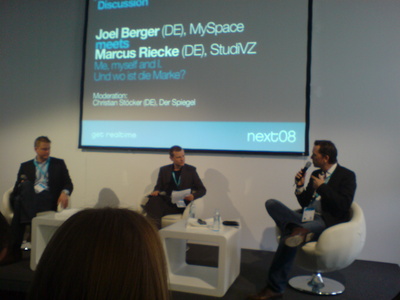 Die Frage nach der Marke ist natürlich doppelsinnig gemeint: Einerseits wie positionieren sich die Social-Networks (SN) untereinander und welche Möglichkeiten bieten sie für die User sich als Marke aufzustellen. Schließlich geht es dort ja nicht zuletzt um die eigene Selbstdarstellung der User. Aber natürlich gehören diese Fragen zusammen.
Die Frage nach der Marke ist natürlich doppelsinnig gemeint: Einerseits wie positionieren sich die Social-Networks (SN) untereinander und welche Möglichkeiten bieten sie für die User sich als Marke aufzustellen. Schließlich geht es dort ja nicht zuletzt um die eigene Selbstdarstellung der User. Aber natürlich gehören diese Fragen zusammen.
Marcus Riecke von StudiVZ zum Beispiel räumt ein, dass die Marke zwar durch die Userführung und die daraus resultierende „Userexpirience“ ein wenig gesteuert werden kann, aber darüber hinaus für die User natürlich die Präsenz des eigenen Freundeskreis die größere Rolle spielt. Riecke steigert sich in die These: „Die Marke wird von den Usern gemacht!“ Dem kann Joel Berger von Myspace nur beipflichten formuliert aber um: „Die Marke kommt von uns, das Produkt vom Nutzer.“
Gegen Myspace und die meisten anderen SNs grenze sich StudiVZ vor allem durch die private Atmosphäre ab. Die Kommunikation sei dort vornehmlich weder kommerziell, noch berufliches Netzwerken. Das mache aber auch den Einsatz von Werbung „sensibel„.
Überhaupt war die Runde schnell auf die Frage nach der „Monetarisierung“ eingeschwenkt. Natürlich betonte jeder für sich die spezifischen Vorteile der eigenen Nutzerschaft, was die Vermarktung angeht (genau bestimmbare Zielgruppe vs. Reichweite).
Lacher erntete Berger als er dem Moderator zur Hilfe sprang, der in dem Satz ins Stocken geriet: „Das Layout der einzelnen Myspaceprofile ist ja manchmal auch etwas …„. – „individuell“ warf Berger helfend ein.
Dann war natürlich auch Googles Open Social ein Thema. Berger betont, dass Myspace ja Gründungsmitglied war. Das betont er aber vor allem, weil StudiVZ derzeit die Aufmerksamkeit auf sich zieht, weil es gerade erst seinen Anschluss angekündigt hatte.
Riecke verwies vor allem auf den Werbemarkt, den StudiVZ damit leichter angehen kann. Wegen der Social-Network-übergreifenden Funktionalität können Werbekunden besser eigene Werbeapplikationen bauen.
Berger monierte, dass die User von heute immer noch mit den Werbekonzepten von gestern abgeholt werden. Da sei noch viel Nachholbedarf auf Seiten der Vermarkter. StudiVZ sieht seine monetarisierte Zukunft in Dingen wie Social-Shopping und Social-Marketing, die in das Social-Network integriert werden sollen.
Ich frage mich nur, wie lange das Konzept Social-Network noch heiß sein wird und ob die Monetarisierung die immer schneller aufpoppenden Trends noch einholen kann. Und wünsche viel Glück.
Lunchbreak: Mingle & Catch Some Rays
While most attendees catch some rays & get to know each other, some have a different agenda.

Martin Recke, organizer of next08, refuses to be stressed out: Despite there being some 1000 folks to take care of, he’s all relaxed. (Thanks!)

Co-blogger Volker Agüeras Gäng makes some plans on his notepad. What you can’t see here is that it says „re:publica 08“ on the back. Cheeky bloggers, eh?

In the meantime, Team Jimdo makes the best of the lunch break by showing off their new Jimdo Race Car in front of the conference building.
Time for us liveblogger to get some food, too: There’s still plenty of sessions to attend!
Real-Time: What’s in it for Brands? – Nils Andres
Wow! That was a quickfire presentation and a stage performance very well done by Nils Andres, founder of the Brand Science Institute (Germany).
He gave the audience some very interessting insights into the ongoing research of his institute and the (possible) future trends of brand marketing and CRM on microblogging and social broadcasting services (e.g. Twitter and JustinTV).
To give you the gist, here is what Nils had to say about what’s in for brands in the realtime market:
— Possibilities:
- Brands can create a live online personality!
- Brands can re-invent their traditional customer support!
- Brands can generate extra sales!
- Low! danger of para-social group behaviour!
- Brands can reach especially women via microblogging and especially the young via Social Broadcasting! (based on their research)
So basically this means to give your brand a „talking face“ costumers can identify with and talk to. Hard enough, if you don’t want to show them „avatar-like TV-ad models!“ Extra sales??? Yeah, bring ‚em on! How to do that is the holy grail of course. But Nils has shared some ideas… so read on!
— Challenges:
- Overcoming the state of being afraid of the unknown! Yes, realtime means leaving behind fallback options. Go engange the costumer, talk to them and help them out. They’ll be happy to love your little brand even more if you reply on Twitter or give them some gold nuggets via Social Boradcasting.
- Realtime is associated with Porn! Yeah, that’s still true somehow but it will change! Brands can change that and users of realtime services are already changing it.
- Realtime what? Not my Job!!! So who’s job is it?: Nils made it pretty clear that companies still have difficulties to assign the „realtime“ job to the right department. Is it PR? Is it Research? Is it Marketing? Is it Advertising?
His answer to this last challenge seemed to be kind of mixed. And he is probably right since it heaviliy depends on your brand and your company’s culture whom you would best assign the really nasty realtime job to. But don’t panic, you’ll make the right decission if follow Nils‘ „water proof“ tipps (wink!).
Here we go:
— What does all that mean for Brands? What should you do?
- Find out (if you don’t already know) if you have a strong Brand Community out there! Nils made it pretty clear that you will need backup from a networked group of brand-enthusiasts that can join your conversations online and help you out when the critics and trolls show up. In short: Your online personality needs friends!.
- Fish where the fish is! Pretty clear what that means, huh?
- Be at the right place at the right time! To reach your audience via microblogging and social broadcasting (especially with the latter) you need to have the right timing. E.g. Be on Justin.Tv when there is action going on. Don’t be there when the user sleeps!
- Cooperate with brand enthuaissats! See #1
- Dont start something that is already popular Don’t re-invent the wheel! Don’t reinvent Twitter. But be a good driver and player in the field! That seemed to be the message here.
- Don’t seperate your fans Check out Amazon’s activities on Twitter. They don’t have one single channel but like a zillion. Although for Amazon this might be a wise decision it might not be a good one for your brands‘ realtime Twitter channel. You don’t want your online personality become a screwed shizophrenic maniac.
- Don’t copy or extend a concept or campaign – Compliment user experience
- Rely on Specialists – Dump Ad-agencies This is really bad news from Nils to your ad-agency. But his point is convincing: They don’t get (yet) what’s going on on microblogging and social broadcasting services. So hire one of them web-culture specialists!
Bottom line: Realtime has to seemlessly fit in with your brand (culture)! If it doesn’t fit don’t do it. It will not be a mass market as Nils pointed out at the end. So: No jumping on hyped-trains but making smart decision to get the best out of it!
